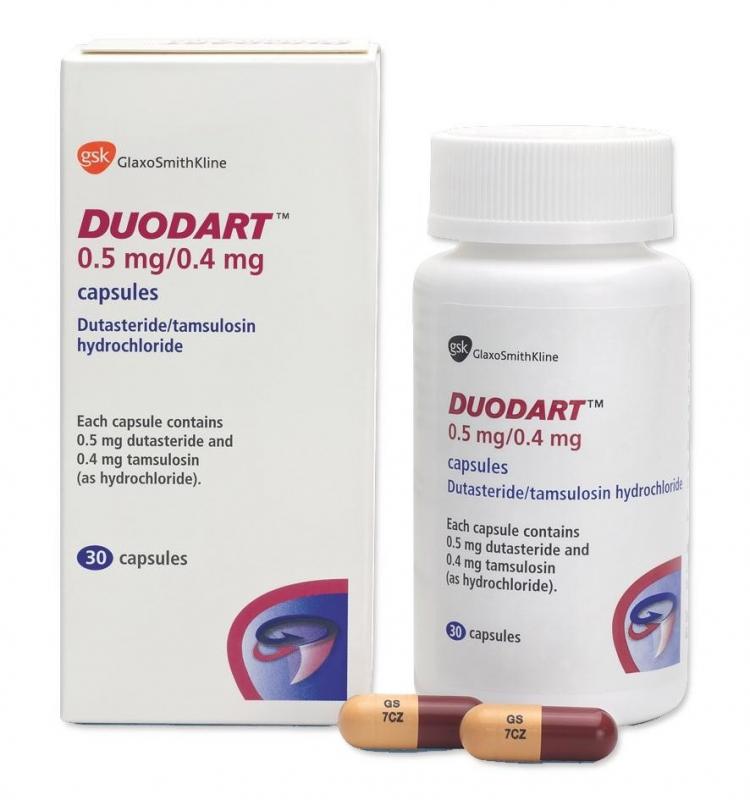Description
Packing
30 pcs.
Pharmacological action
Duodart® is a combined preparation of dutasteride and tamsulosin with a complementary mechanism of action.
Dutasteride is a dual inhibitor of 5β-reductase, inhibits the activity of isoenzymes of 5β-reductase types 1 and 2, which are responsible for the conversion of testosterone to 5β-dihydrotestosterone.
Dihydrotestosterone (DHT) is the main androgen responsible for prostatic gland hyperplasia. Dutasteride reduces the level of DHT, reduces the size of the prostate gland, reduces the symptoms of the disease, improves urination, reduces the risk of acute urinary retention and the need for surgical treatment.
The maximum effect of dutasteride on lowering the concentration of DHT is dose-dependent and is observed 1–2 weeks after the start of treatment. After 1-2 weeks of taking dutasteride at a dose of 0.5 mg / day, the median serum DHT concentrations are reduced by 85–90%, respectively.
In patients with benign prostatic hyperplasia (BPH) when taking dutasteride at a dose of 0. 5 mg / day, the average decrease in DHT levels was 94% during the first year and 93% – during the second year of therapy, the average serum testosterone levels increased by 19% during the first and second years of treatment. This effect is due to a decrease in the level of 5β-reductase and does not lead to the development of any known adverse reactions.
Tamsulosin hydrochloride is a blocker of postsynaptic 1a-adrenergic receptors located in the smooth muscles of the prostate gland, bladder neck and prostatic urethra.
Blockade of 1a-adrenergic receptors leads to a decrease in smooth muscle tone of the prostate gland, bladder neck and prostatic urethra and an improvement in urine outflow. At the same time, both obstructive symptoms and irritative symptoms are reduced, due to the increased tone of smooth muscles and detrusor hyperactivity in BPH.
Indications
– treatment and prevention of progression of benign prostatic hyperplasia (reducing its size, reducing symptoms, improving urination, reducing the risk of acute urinary retention and the need for surgical treatment).
Contraindications
– women
– children and adolescents under the age of 18
– severe liver failure
– history of orthostatic hypotension
history – planned surgery for cataract
– known hypersensitivity to others -reductases or to any other ingredient of the drug.
Use during pregnancy and lactation
The drug Duodart® is contraindicated for use in women.
There is no data on the excretion of dutasteride or tamsulosin with breast milk.
The use of dutasteride has not been studied in women, because preclinical data suggest that suppressing the level of DHT in the circulation may interfere with the formation of external genitalia in male fetuses if the mother received dutasteride during pregnancy.
Special instructions
Dutasteride is absorbed through the skin, so women and children should avoid contact with damaged capsules. In case of contact with damaged capsules, immediately wash the corresponding skin area with soap and water.
The combined use of tamsulosin and potent inhibitors of CYP3A4 (ketoconazole), CYP2D6 (paroxetine), as well as their weaker inhibitors, leads to an increase in tamsulosin exposure. Therefore, the use of tamsulosin in combination with strong CYP3A4 inhibitors is not recommended combination of CYP2D6 inhibitors and tamsulosin should be prescribed with caution.
Since T1 / 2 of dutasteride is 3-5 weeks and is metabolized mainly in the liver, DuodartВ® should be used with caution in patients with liver disease.
Combination therapy with tamsulosin hydrochloride and the development of heart failure
In two 4-year clinical trials, the incidence of heart failure (a composite term for the events that occurred was mainly heart failure and congestive heart failure) was higher in patients receiving a combination of dutasteride and alpha1-blocker, mainly tamsulosin hydrochloride, than in patients not receiving combined treatment. In two 4-year clinical studies, the incidence of heart failure remained low ( 1%) and varied between studies. But in general, there were no discrepancies in the frequency of side effects from the cardiovascular system. No causal relationship has been established between treatment with dutasteride (alone or in combination with alpha1-blocker) and heart failure.
Influence on the detection of PSA and prostate cancer
In patients with BPH, a digital rectal examination and other methods of examining the prostate should be performed before treatment with DuodartВ® and periodically repeat these studies during treatment to exclude the development of prostate cancer.
Determining serum PSA concentrations is an important component of the screening process to detect prostate cancer.
After 6 months of therapy, dutasteride reduces serum PSA levels in patients with BPH by approximately 50%.
Patients taking DuodartВ® should be given a new baseline PSA level after 6 months of therapy.
Any stable increase in PSA relative to the smallest value with DuodartВ® treatment may indicate the development of prostate cancer (in particular, Gleason’s high-grade prostate cancer) or non-compliance with the DuodartВ® therapy regimen and should be carefully evaluated, even if these PSA levels remain within normal limits in patients not taking 5ОІ-reductase inhibitors.
Total PSA returns to baseline within 6 months after dutasteride withdrawal.
The ratio of free PSA to total remains constant even with dutasteride therapy. When expressing this ratio in shares for the detection of prostate cancer in men receiving dutasteride, correction of this value is not required.
Risk of developing breast cancer
In clinical trials during the treatment of BPH, 2 cases of developing breast cancer in patients using dutasteride were detected. The first case developed 10 weeks after the start of therapy, the second – after 11 months, 1 case of breast cancer was also detected in a patient from the placebo group. The relationship between the long-term use of dutasteride and the risk of developing breast cancer is unknown.
Prostate cancer
In a clinical study over 4 years in 1517 of more than 8000 men with preliminary negative biopsy results and a PSA level of 2.5-10 ng / ml, prostate cancer was diagnosed. A higher incidence of cancer was observed in patients from the dutasteride group (n = 29, 0.9%) compared with the placebo group (n = 19, 0.6%). There was no interaction between dutasteride and prostate cancer. Men taking dutasteride should be tested regularly for prostate cancer risk, including a PSA test.
Arterial hypotension
As with any alpha-1 blocker, orthostatic hypotension may occur with tamsulosin hydrochloride, which in rare cases leads to fainting.
Patients starting treatment with DuodartВ® should be warned about the need to sit down or lie down at the first sign of orthostatic hypotension (dizziness) until dizziness passes.
In order to avoid the development of symptomatic hypotension, caution should be exercised when co-administering alpha1-blockers and PDE5 inhibitors, as these drugs belong to the group of vasodilators and can lead to a decrease in blood pressure.
Floppy-iris syndrome
Intraoperative Atonic Iris Syndrome (IFIS, a type of small pupil syndrome) has been observed in cataract surgery in some patients treated with alpha1-blockers, including tamsulosin hydrochloride. Atonic iris syndrome can lead to an increase in the number of complications during operations.
During a preoperative examination, the ophthalmic surgeon should clarify whether the patient is taking a combination of dutasteride with tamsulosin hydrochloride to be able to prepare for surgery, and to take adequate measures in case of iris atony intraoperatively.
Withdrawal of tamsulosin hydrochloride 1–2 weeks before cataract surgery is considered beneficial, but the benefits and time period for discontinuation of the drug before cataract surgery have not been established.
Impaired liver function
There is currently no data on the use of the drug DuodartВ® in patients with impaired liver function. Because dutasteride undergoes intensive metabolism, and its T1 / 2 is 3-5 weeks, care must be taken when treating patients with impaired liver function with DuodartВ®.
Influence on the ability to drive vehicles and control mechanisms
No studies have been conducted that have studied the effect on driving a car and working with mechanisms.
Patients should be informed of the possibility of symptoms associated with orthostatic hypotension, such as dizziness. Care must be taken when driving vehicles or potentially dangerous machinery.
Dosage and administration
For adults (including the elderly), 1 capsule (0.5 mg / 0.4 mg) is prescribed orally, 1 time / day, 30 minutes after the same meal, washed down with water.
Capsules should be taken whole without opening or chewing, since contact of the contents of the capsule with the oral mucosa can cause inflammation from the mucosa.
There is currently no data on the use of the drug Duodart® in patients with impaired renal function.
There is no need for dose adjustment in this cohort of patients.
There is currently no data on the use of the drug Duodart® in patients with impaired liver function.
The drug should be used with caution in patients with mild to moderate liver failure. Duodart® is contraindicated in patients with severe liver failure.
Side effects
Adverse events due to the use of tamsulosin hydrochloride in combination with dutasteride
Very rare (<1/10 000): impotence, decreased libido, impaired ejaculation, gynecomastia, breast tenderness, dizziness. Sexual disorders are associated with the use of the dutasteride component and may persist after discontinuation of therapy. Adverse events due to the use of dutasteride as monotherapy Rarely (? 1/10 000 and <1/1000): alopecia (mainly hair loss on the body), hypertrichosis. Very rare (<1/10 000): depression, pain, and swelling in the testicles. Adverse events due to the use of tamsulosin hydrochloride as monotherapy Often (? 1/100 and <1/10): dizziness, impaired ejaculation. Infrequently (? 1/1000 and <1/100): palpitations, constipation, diarrhea, vomiting, asthenia, rhinitis, rash, itching, urticaria, postural hypotension. Rarely (? 1/10 000 and <1/1000): loss of consciousness, angioedema. Very rare (<1/10 000): priapism, Stevens-Johnson syndrome. Postmarketing studies Intraoperative Atonic Iris Syndrome (IFIS, a type of small pupil syndrome) has been observed in cataract surgery in some patients who received alpha1-blockers, including tamsulosin hydrochloride. Cases of the development of atrial fibrillation, arrhythmias, tachycardia, and dyspnea have been identified with tamsulosin. The frequency of adverse reactions and the relationship with tamsulosin have not been established. Drug Interactions No drug interaction studies have been conducted for the combination of dutasteride with tamsulosin hydrochloride. The data below reflects the available information on the individual components. Dutasteride Dutasteride is metabolized by the cytochrome P450 enzyme isoenzyme CYP3A4. In the presence of CYP3A4 inhibitors, blood dutasteride concentrations may increase. With the simultaneous use of dutasteride with CYP3A4 inhibitors, verapamil and diltiazem, a decrease in the clearance of dutasteride by 37% and 44%, respectively. However, amlodipine, another calcium channel blocker, does not reduce the clearance of dutasteride. A decrease in the clearance of dutasteride and a subsequent increase in its concentration in the blood with the simultaneous use of this drug and CYP3A4 inhibitors is not significant due to the wide range of safety limits of this drug, so there is no need to reduce its dose. In vitro dutasteride is not metabolized by the following isoenzymes of the human cytochrome P450 system: CYP1A2, CYP2A6, CYP2E1, CYP2C8, CYP2C9, CYP2C19, CYP2B6 and CYP2D6. Dutasteride does not inhibit in vitro human cytochrome P450 system enzymes involved in drug metabolism. Dutasteride does not displace warfarin, acenocoumarol, fenprocoumone, diazepam and phenytoin from the sites of their binding to plasma proteins, and these drugs, in turn, do not displace dutasteride. No effect was observed on the pharmacokinetics and pharmacodynamics of the combined use of dutasteride in combination with tamsulosin, terazosin, warfarin, digoxin and cholesterol. When using dutasteride simultaneously with lipid-lowering drugs, ACE inhibitors, beta-blockers, calcium channel blockers, corticosteroids, diuretics, NSAIDs, PDE5 inhibitors and quinolone antibiotics, no significant drug interaction is noted. Tamsulosin hydrochloride There is a theoretical risk of an increase in the hypotensive effect when tamsulosin hydrochloride is used in conjunction with drugs that can lower blood pressure, including anesthetics, alpha1-blockers and PDE5 inhibitors. The drug Duodart® should not be used in combination with other alpha-1 blockers. The combined use of tamsulosin and ketoconazole (a strong inhibitor of CYP3A4) leads to an increase in Cmax and AUC of tamsulosin hydrochloride to 2.2 and 2.8, respectively. The co-administration of tamsulosin and paroxetine (a strong inhibitor of CYP2D6) leads to an increase in Cmax and AUC of tamsulosin hydrochloride to 1.3 and 1.6, respectively. The combined use of CYP2D6 and CYP3A4 inhibitors with tamsulosin has not been studied, but with this combination a significant increase in tamsulosin exposure is expected. The simultaneous use of tamsulosin hydrochloride (0.4 mg) and cimetidine (400 mg every 6 hours) for 6 days led to a decrease in clearance (by 26%) and an increase in AUC of tamsulosin hydrochloride (by 44%). Caution is required when using the drug Duodart ® and cimetidine together. An exhaustive study of the drug interaction between tamsulosin hydrochloride and warfarin has not been conducted. Caution should be exercised while using warfarin and tamsulosin hydrochloride. In three studies in which tamsulosin hydrochloride (0.4 mg for 7 days, then 0.8 mg for the next 7 days) was taken with atenolol, enalapril or nifedipine for 3 months, no interaction was detected, therefore, there is no need for correction doses when using these drugs with Duodart®. The simultaneous use of tamsulosin hydrochloride (0.4 mg / day for 2 days, then 0.8 mg / day for 5-8 days) and a single intravenous administration of theophylline (5 mg / kg) did not lead to a change in theophylline pharmacokinetics, therefore, did not dose adjustment required. The concomitant use of tamsulosin hydrochloride (0.8 mg / day) and a single iv dose of furosemide (20 mg) resulted in a decrease of 11 to 12% of Cmax and AUC of tamsulosin hydrochloride, however, these changes are expected to be clinically insignificant and dose adjustment . Combined use of dutasteride and tamsulosin hydrochloride In two 4-year clinical trials, the incidence of heart failure (a composite term for these events, mainly heart failure and congestive heart failure) was higher in patients who received a combination of dutasteride and alpha1-blocker, mainly tamsulosin hydrochloride than in patients not receiving combination treatment. In two 4-year clinical studies, the incidence of heart failure remained low ( 1%) and varied between studies. But in general, there were no discrepancies in the frequency of side effects from the cardiovascular system. No causal relationship has been established between treatment with dutasteride (alone or in combination with alpha1-blocker) and heart failure. Overdose There is no evidence of an overdose with the combination of dutasteride with tamsulosin hydrochloride. The data below reflects the information available about the individual components. Dutasteride Symptoms: no adverse events were observed with dutasteride up to 40 mg / day (80 times the therapeutic dose) for 7 days. In clinical trials, administration of 5 mg / day for 6 months of adverse reactions in addition to those listed for therapeutic dose (0.5 mg / day) was not observed. Treatment: There is no specific antidote to dutasteride, so it is sufficient to carry out symptomatic and supportive treatment in case of overdose. Tamsulosin hydrochloride Symptoms: Acute hypotension may develop with an overdose of tamsulosin hydrochloride. Treatment: symptomatic therapy. HELL can be restored when a person takes a horizontal position. In the absence of an effect, agents that increase BCC and, if necessary, vasoconstrictor agents, can be used. Kidney function must be monitored. Dialysis is unlikely to be effective since tamsulosin hydrochloride is bound to plasma proteins by 94-99%. Active Dutasteride pharmacy pharmacy terms pharmacy Form of Treatment kapsul prolongirovannogo action Katalent Germani Schorndorf GmbH, Germany




